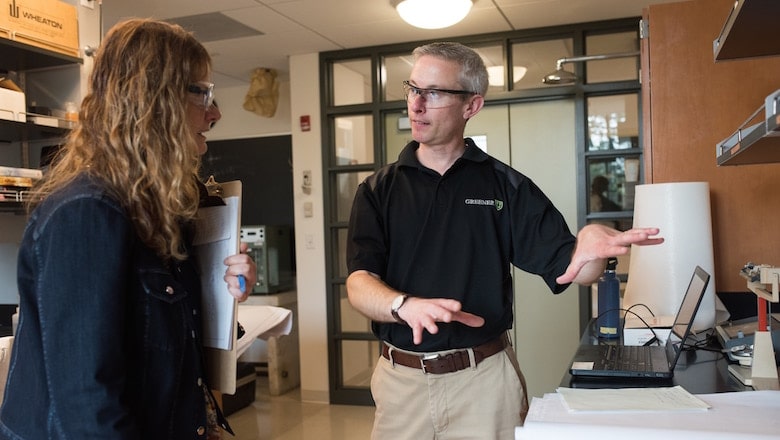Right-sizing laboratory ventilation: Smith’s Ford Hall gets an energy retrofit using a three-pronged approach
Ford Hall, a science laboratory building, was one of the top energy users on the Smith College campus. GreenerU helped to calibrate laboratory ventilation while balancing air quality, addressing environmental safety concerns while lowering energy use.

“Laboratory efficiency” can seem like an oxymoron sometimes.
Environmental health and safety experts often prefer as much air flow as possible in a laboratory, which removes toxic fumes and poor quality air from a space. But the problem is that high-volume ventilation also means constant reconditioning of indoor air, and that is an energy-intensive problem many colleges face.
Recognizing that there may be no single right answer when it comes to appropriate air volume levels in a lab, GreenerU approaches laboratory efficiency using a three-pronged approach: (1) engaging stakeholders, (2) working with a lab safety expert, and (3) optimizing equipment. The intended result is to find that sweet spot where ventilation is at the most appropriate levels—not too much to waste energy, but enough to ensure everyone can breathe easy. Literally.
A holistic approach to energy savings
Ford Hall, a science laboratory building, is one of the top energy users on the Smith College campus. Smith has a long-term energy master plan to achieve its carbon neutrality commitments, which include energy conservation measures.
To assess energy-saving opportunities at Ford Hall, GreenerU first performed a detailed energy audit, which included a walking focus group to gather insights from users, building managers, and facilities on how a space is used. The technical assistance study offered a menu of energy conservation measures and cost estimates; Smith in turn selected which measures they wanted to move forward with.
Starting in 2017, GreenerU went for a very common and easy win: we traded out fluorescent lights for LED bulbs in common areas and corridors.
Following that, we worked with a leading lab ventilation specialist to perform a laboratory ventilation risk assessment. This involves performing a detailed equipment inventory, testing fume hoods for air flow, and assessing potential safety hazards associated with the laboratories. The goals were to determine optimal air flow rates for safety and efficiency.
Engaging stakeholders for smooth communications
GreenerU had regular meetings with a core team of facilities folks at Smith College: Margaret Rakas from environmental health and safety, project manager Gary Hartwell, administrative coordinator Heather McQueen, chemistry professor Kevin Shea, and Clark Science Center administrative director Tom Richardson. The main goal of these meetings was to offer up a detailed communications plan to ensure minimum disruption to lab users.
“Roughly a dozen professors and lab instructors kept a close eye on the project,” said Hartwell. “The team at GreenerU was extremely sensitive to the needs of our users.”
The fix
Ultimately, GreenerU moved forward with the implementation of a number of energy conservation measures revolving around optimizing laboratory ventilation and controls, reducing some fume hood face velocities, and reducing excessive air flow and air exchange rates in individual lab spaces. One major building-level change was to switch from a fixed to a variable exhaust fan speed and advanced static pressure reset, which shifts a clunky “on/off” feature to one of greater nuance.
One persnickety issue Ford Hall had, which GreenerU has corrected, was a wall switch in classroom laboratories to turn off all fume hoods at once. When hoods were left open too long, the system’s default was to set off a shrill, 60-second alarm. That led to building managers simply deactivating the system and leaving the fume hoods open at all times. To resolve this, GreenerU worked with Smith to set up a gentler reminder: after 4-5 hours open, flashing lights and a three-second, muted alarm will issue a warning that fume hoods will automatically close.
The results
In the end, Smith was able to achieve a complex goal with this project: to calibrate laboratory ventilation while balancing air quality, and to address environmental safety concerns while lowering energy use. What’s more, GreenerU identified and repaired faulty reheat valves in parts of the building that were causing some spaces to be so chilly your fingers would turn purple—even in summertime. Now the building is breathing, heating, and cooling to comfortable levels. What’s more, GreenerU’s process helped open lines of communication between facilities, safety staff, and faculty.
With these new energy conservation measures, Smith has reduced its annual energy use by almost 7,000 MMBtus, reducing emissions by 537 metric tons of carbon equivalent and saving $144,000 each year in utility bills. Working across departments, engaging the right expertise, and fine-tuning Ford’s ventilation system has been key to a great partnership.
Most importantly, Hartwell was pleased with GreenerU’s responsiveness. “When questions came up, they were answered promptly and professionally,” he said. “It was a pleasure working with the team.”
GreenerU is proud to have worked with many colleges on improving laboratory energy efficiency, keeping air quality, comfort, and lab users in mind. Contact us at info@greeneru.com if you’d like to start a conversation on how you can reduce energy in your laboratory spaces on campus.



